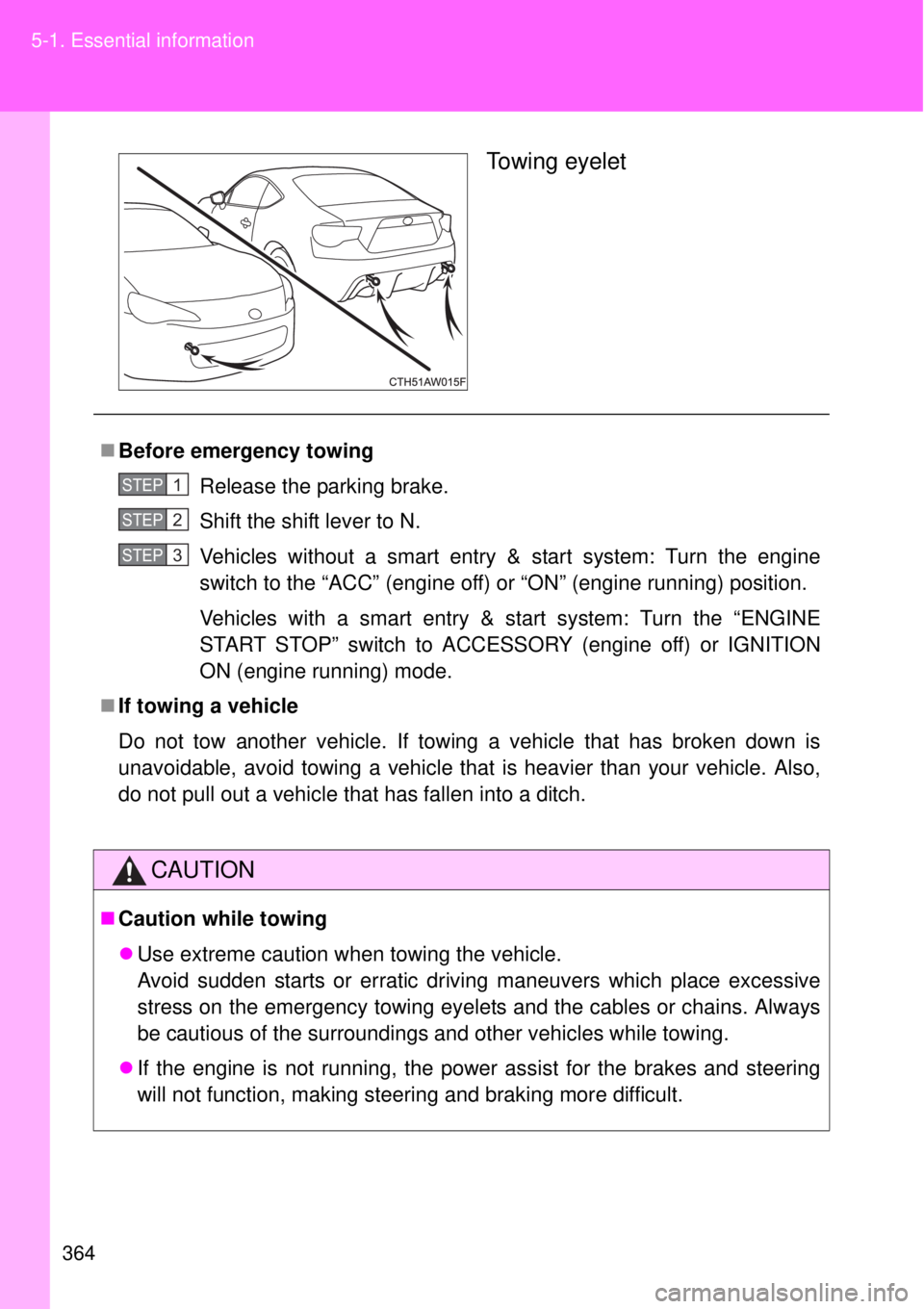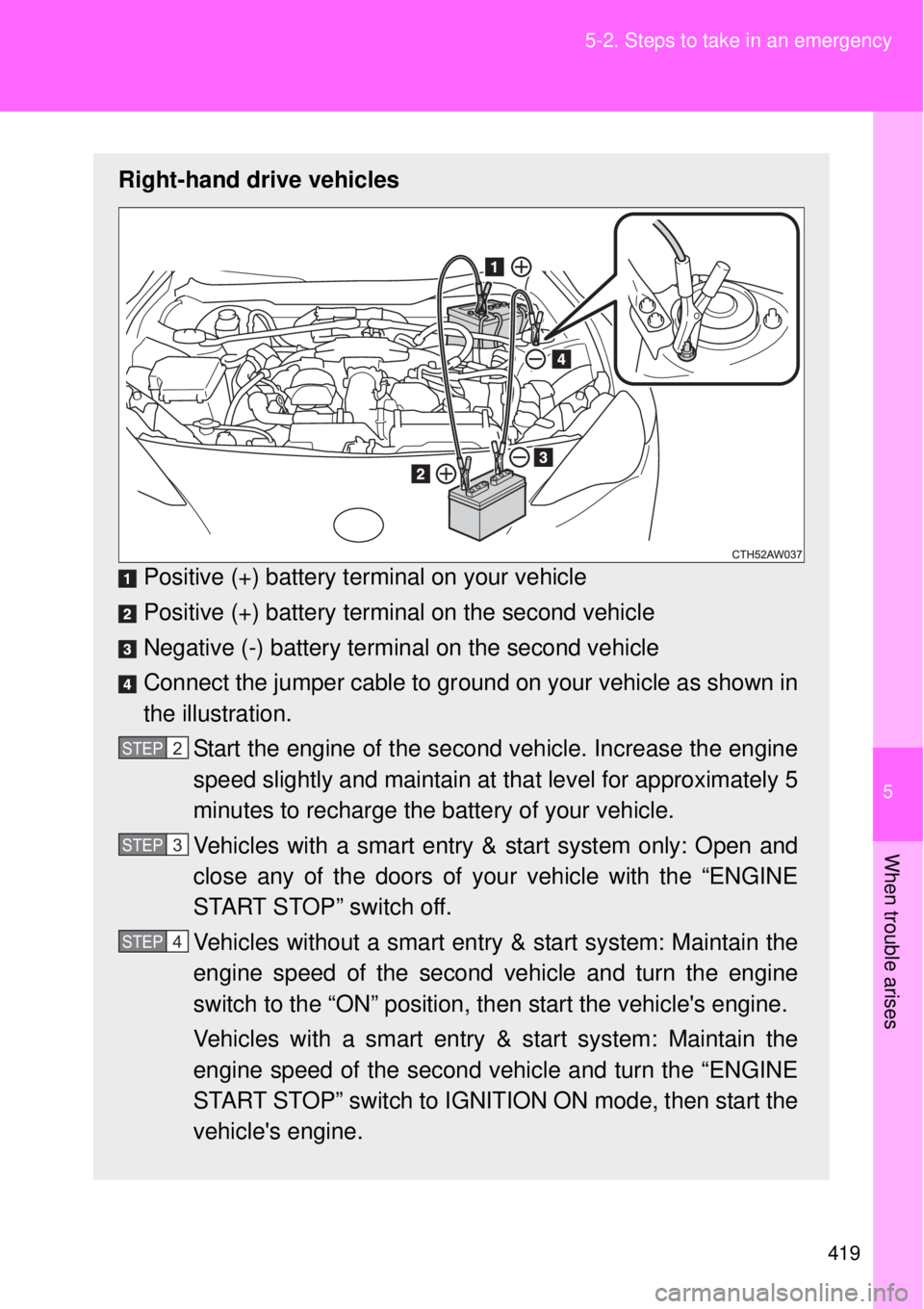Page 317 of 464
317 4-3. Do-it-yourself maintenance
4
Maintenance and care
Vehicles with a smart entry & start system: Wait for a few min-
utes with the “ENGINE START STOP” switch in IGNITION ON
mode and then turn the “ENGINE START STOP” switch off.
Vehicles without a smart entry & start system: Wait for a few
minutes with the engine switch in the “ON” position and then
turn the engine switch to the “ACC” or “LOCK” position.
Registering ID codes
The tire pressure warning valve and transmitter is equipped with a
unique ID code. When replacing a tire pressure warning valve and
transmitter, it is necessary to register the ID code. Have the ID code
registered by any authorized Toyota dealer or repairer, or another
duly qualified and equipped professional.
STEP 5
Page 364 of 464

364 5-1. Essential information
Towing eyelet
Before emergency towing
Release the parking brake.
Shift the shift lever to N.
Vehicles without a smart entry & start system: Turn the engine
switch to the “ACC” (engine off) or “ON” (engine running) position.
Vehicles with a smart entry & start system: Turn the “ENGINE
START STOP” switch to ACCESSORY (engine off) or IGNITION
ON (engine running) mode.
If towing a vehicle
Do not tow another vehicle. If towing a vehicle that has broken down is
unavoidable, avoid towing a vehicle that is heavier than your vehicle. Also,
do not pull out a vehicle that has fallen into a ditch.
CAUTION
Caution while towing
Use extreme caution when towing the vehicle.
Avoid sudden starts or erratic driving maneuvers which place excessive
stress on the emergency towing eyelets and the cables or chains. Always
be cautious of the surroundings and other vehicles while towing.
If the engine is not running, the power assist for the brakes and steering
will not function, making steering and braking more difficult.
STEP 1
STEP 2
STEP 3
Page 378 of 464

378 5-2. Steps to take in an emergency
If the tire pressure warning system is inoperative
The tire pressure warning system will be disabled in the following conditions:
(When the condition becomes normal, the system will work properly.)
If tires not equipped with tire pressure warning valves and transmitters
are used.
If the ID code on the tire pressure warning valves and transmitters is not
registered in the tire pressure warning computer.
If the tire inflation pressure is 380 kPa (3.87 kgf/cm
2 or bar, 55 psi) or
higher.
The tire pressure warning system may be disabled in the following condi-
tions:
(When the condition becomes normal, the system will work properly.)
If electronic devices or facilities using similar radio wave frequencies are
nearby.
If a radio set at similar frequencies is in use in the vehicle.
If a window tint that affects the radio wave signals is installed.
If there is a lot of snow or ice on the vehicle, in particular around the
wheels or wheel housings.
If non-genuine Toyota wheels are used. (Even if you use Toyota wheels,
the tire pressure warning system may not work properly with some types
of tires.)
If tire chains are used.
If a large metallic object which can interfere with signal reception is put in
the trunk.
If the tire pressure warning light frequently comes on after blinking for
approximately one minute
If the tire pressure warning light frequently comes on after blinking for
approximately one minute when the “ENGINE START STOP” switch is
turned to IGNITION ON mode (vehicles with a smart entry & start system) or
the engine switch is turned to the “ON” position (vehicles without a smart
entry & start system), have it checked by any authorized Toyota dealer or
repairer, or another duly qualified and equipped professional.
Page 415 of 464
5
415 5-2. Steps to take in an emergency
When trouble arises
Starting the engine
Vehicles with an automatic transmission
Ensure that the shift lever is in P and firmly depress the brake
pedal.
Touch the Toyota emblem side of
the electronic key to the
“ENGINE START STOP” switch.
When the electronic key is
detected, a buzzer sounds and
the “ENGINE START STOP”
switch will turn to IGNITION ON
mode.
When the smart entry & start sys-
tem is deactivated in customiza-
tion setting, the “ENGINE START
STOP” switch will turn to ACCES-
SORY mode.
Firmly depress the brake pedal and check that the smart entry
& start system indicator light (green) turns on.
Press the “ENGINE START STOP” switch.
In the event that the “ENGINE START STOP” switch still cannot be
operated, contact any authorized Toyota dealer or repairer, or another
duly qualified and equipped professional.
STEP 1
STEP 2
STEP 3
STEP 4
Page 416 of 464
416 5-2. Steps to take in an emergency
Vehicles with a manual transmission
Ensure that the shift lever is in N and depress the clutch
pedal.
Touch the Toyota emblem side of
the electronic key to the
“ENGINE START STOP” switch.
When the electronic key is
detected, a buzzer sounds and
the “ENGINE START STOP”
switch will turn to IGNITION ON
mode.
When the smart entry & start sys-
tem is deactivated in customiza-
tion setting, the “ENGINE START
STOP” switch will turn to ACCES-
SORY mode.
Firmly depress the clutch pedal and check that the smart
entry & start system indicator light (green) turns on.
Press the “ENGINE START STOP” switch.
In the event that the “ENGINE START STOP” switch still cannot be
operated, contact any authorized Toyota dealer or repairer, or another
duly qualified and equipped professional.
STEP 1
STEP 2
STEP 3
STEP 4
Page 419 of 464

5
419 5-2. Steps to take in an emergency
When trouble arises
Right-hand drive vehicles
Positive (+) battery terminal on your vehicle
Positive (+) battery terminal on the second vehicle
Negative (-) battery terminal on the second vehicle
Connect the jumper cable to ground on your vehicle as shown in
the illustration.
Start the engine of the second vehicle. Increase the engine
speed slightly and maintain at that level for approximately 5
minutes to recharge the battery of your vehicle.
Vehicles with a smart entry & start system only: Open and
close any of the doors of your vehicle with the “ENGINE
START STOP” switch off.
Vehicles without a smart entry & start system: Maintain the
engine speed of the second vehicle and turn the engine
switch to the “ON” position, then start the vehicle's engine.
Vehicles with a smart entry & start system: Maintain the
engine speed of the second vehicle and turn the “ENGINE
START STOP” switch to IGNITION ON mode, then start the
vehicle's engine.
STEP 2
STEP 3
STEP 4
Page 439 of 464
439 6-1. Specifications
6
Vehicle specifications
Cooling system
Ignition system
CapacityVehicles with an automatic transmission
7.5 L (7.9 qt., 6.6 Imp. qt.)
Vehicles with a manual transmission
7.2 L (7.6 qt., 6.3 Imp. qt.)
Coolant typeUse either of the following.
• “TOYOTA Genuine 50/50 Pre-mixed Super Long
Life Coolant BLUE”
• Similar high-quality ethylene glycol-based non-
silicate, non-amine, non-nitrite, and non-borate
coolant with long-life hybrid organic acid technol-
ogy
Do not use plain water alone.
Spark plug
Make
GapDENSO ZXE27HBR8
0.8 mm (0.031 in.)
NOTICE
Iridium-tipped spark plugs
Use only iridium-tipped spark plugs. Do not adjust gap when tuning engine.
Page 454 of 464

454 Alphabetical index
Electric power steering ........... 225
Electronic key
If the electronic key does
not operate properly ........... 414
Emergency flashers
Switch ................................... 362
Emergency, in case of
If the electronic key does
not operate properly ........... 414
If the engine will not start ...... 409
If the shift lever cannot
be shifted from P ................ 412
If the vehicle has a
discharged battery .............. 418
If the warning buzzer
sounds ................................ 372
If the warning light
turns on............................... 372
If you have a flat tire ..... 384, 393
If you lose your keys ............. 413
If you think something is
wrong .................................. 370
If your vehicle becomes
stuck ................................... 426
If your vehicle has to be
stopped in an
emergency .......................... 428
If your vehicle needs to
be towed ............................. 363
If your vehicle overheats ....... 423Engine
Compartment ........................ 301
Engine switch................ 169, 178
Hood ..................................... 297
How to start the
engine......................... 169, 178
Identification number ............ 433
If the engine will not start ...... 409
Ignition switch ............... 169, 178
Overheating .......................... 423
Engine coolant
Capacity ................................ 439
Checking ............................... 305
Engine coolant temperature
gauge...................................... 194
Engine immobilizer system ...... 91
Engine oil
Capacity ................................ 436
Checking ............................... 302
Preparing and checking
before winter....................... 233
Engine switch .................. 169, 178
Engine switch light .................. 259
EPS ........................................... 225
Event data recorder ................... 24E